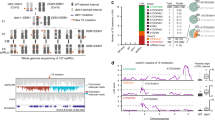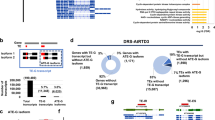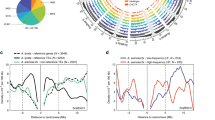Abstract
High-copy-number transposable elements comprise the majority of eukaryotic genomes where they are major contributors to gene and genome evolution1. However, it remains unclear how a host genome can survive a rapid burst of hundreds or thousands of insertions because such bursts are exceedingly rare in nature and therefore difficult to observe in real time2. In a previous study we reported that in a few rice strains the DNA transposon mPing was increasing its copy number by ∼40 per plant per generation3. Here we exploit the completely sequenced rice genome to determine 1,664 insertion sites using high-throughput sequencing of 24 individual rice plants and assess the impact of insertion on the expression of 710 genes by comparative microarray analysis. We find that the vast majority of transposable element insertions either upregulate or have no detectable effect on gene transcription. This modest impact reflects a surprising avoidance of exon insertions by mPing and a preference for insertion into 5′ flanking sequences of genes. Furthermore, we document the generation of new regulatory networks by a subset of mPing insertions that render adjacent genes stress inducible. As such, this study provides evidence for models first proposed previously4,5,6 for the involvement of transposable elements and other repetitive sequences in genome restructuring and gene regulation.
This is a preview of subscription content, access via your institution
Access options
Subscribe to this journal
Receive 51 print issues and online access
$199.00 per year
only $3.90 per issue
Buy this article
- Purchase on Springer Link
- Instant access to full article PDF
Prices may be subject to local taxes which are calculated during checkout




Similar content being viewed by others
References
Feschotte, C. Transposable elements and the evolution of regulatory networks. Nature Rev. Genet. 9, 397–405 (2008)
Feschotte, C., Jiang, N. & Wessler, S. R. Plant transposable elements: where genetics meet genomics. Nature Rev. Genet. 3, 329–341 (2002)
Naito, K. et al. Dramatic amplification of a rice transposable element during recent domestication. Proc. Natl Acad. Sci. USA 103, 17620–17625 (2006)
McClintock, B. The significance of responses of the genome to challenge. Science 226, 792–801 (1984)
Britten, R. J. & Davidson, E. H. Gene regulation for higher cells: a theory. Science 165, 349–357 (1969)
Britten, R. J. & Davidson, E. H. Repetitive and non-repetitive DNA sequences and a speculation on the origins of evolutionary novelty. Q. Rev. Biol. 46, 111–138 (1971)
Jiang, N. et al. Active DNA transposon family in rice. Nature 421, 163–167 (2003)
Kikuchi, K., Terauchi, K., Wada, M. & Hirano, H. Y. The plant MITE mPing is mobilized in anther culture. Nature 421, 167–170 (2003)
Margulies, M. et al. Genome sequencing in microfabricated high-density picolitre reactors. Nature 437, 376–380 (2005)
Arnold, C. & Hodgson, I. J. Vectorette PCR: a novel approach to genomic walking. PCR Methods Appl. 1, 39–42 (1991)
Itoh, T. et al. Curated genome annotation of Oryza sativa ssp. japonica and comparative genome analysis with Arabidopsis thaliana . Genome Res. 17, 175–183 (2007)
Cresse, A. D., Hulbert, S. H., Brown, W. E., Lucas, J. R. & Bennetzen, J. L. Mu1-related transposable elements of maize preferentially insert into low copy number DNA. Genetics 140, 315–324 (1995)
Liao, G. C., Rehm, E. J. & Rubin, G. M. Insertion site preferences of the P transposable element in Drosophila melanogaster . Proc. Natl Acad. Sci. USA 97, 3347–3351 (2000)
Miyao, A. et al. Target site specificity of the Tos17 retrotransposon shows a preference for insertion within genes and against insertion in retrotransposon-rich regions of the genome. Plant Cell 15, 1771–1780 (2003)
Piffanelli, P. et al. Large-scale characterization of Tos17 insertion sites in a rice T-DNA mutant library. Plant Mol. Biol. 65, 587–601 (2007)
Kolesnik, T. et al. Establishing an efficient Ac/Ds tagging system in rice: Large-scale analysis of Ds flanking sequences. Plant J. 37, 301–314 (2004)
Yu, J. et al. A draft sequence of the rice genome (Oryza sativa L. ssp. indica). Science 296, 79–92 (2002)
Mavrich, T. N. et al. Nucleosome organization in the Drosophila genome. Nature 453, 358–362 (2008)
Kaplan, N. et al. The DNA-encoded nucleosome organization of a eukaryotic genome. Nature 458, 362–366 (2009)
Shimono, M. et al. WRKY45 plays a crucial role in benzothiadiazole-inducible blast resistance. Plant Cell 19, 2064–2076 (2007)
Jiang, N. et al. Dasheng: a recently amplified nonautonomous long terminal repeat element that is a major component of pericentromeric regions in rice. Genetics 161, 1293–1305 (2002)
Monden, Y. et al. High potential of a transposon mPing as a marker system in japonica × japonica cross in rice. DNA Res. 16, 131–140 (2009)
Higo, K., Ugawa, Y., Iwamoto, M. & Korenaga, T. Plant cis-acting regulatory DNA elements (PLACE) database. Nucleic Acids Res. 27, 297–300 (1999)
McClintock, B. The relation of homozygous deficiencies to mutations and allelic series in maize. Genetics 29, 478–502 (1944)
Yang, G., Zhang, F., Hancock, C. N. & Wessler, S. R. Transposition of a rice miniature inverted-repeat transposable element mPing in Arabidopsis thaliana . Proc. Natl Acad. Sci. USA 104, 10962–10967 (2007)
Capy, P., Gasperi, G., Biemont, C. & Bazin, C. Stress and transposable elements: co-evolution or useful parasites? Heredity 85, 101–106 (2000)
Feschotte, C., Zhang, X. & Wessler, S. R. in Mobile DNA II Ch. 50 (eds Craig, N. L., Craigie, R., Gellert, M. & Lambowitz, A. M.) 1147–1158 (ASM Press, 2002)
Delihas, N. Small mobile sequences in bacteria display diverse structure/function motifs. Mol. Microbiol. 67, 475–481 (2007)
Curtis, M. D. & Grossniklaus, U. A gateway cloning vector set for high-throughput functional analysis of genes in planta . Plant Physiol. 133, 462–469 (2003)
Clough, S. J. & Bent, A. F. Floral dip: a simplified method for Agrobacterium-mediated transformation of Arabidopsis thaliana . Plant J. 16, 735–743 (1998)
Acknowledgements
We thank the Rice Genome Resource Center for the use of the rice microarray system and Y. Nagamura and R. Motoyama for technical support; the GenBank project of the National Institute of Agrobiological Science in Japan for providing seeds of Gimbozu landraces (A123 and A157); and X. Zhang and C. Feschotte for critical discussions and reading of the manuscript. S.R.W. is funded by a NSF Plant Genome grant and the University of Georgia Research Foundation and T.Tanisaka by the Ministry of Education, Culture, Sports, Science and Technology of Japan.
Author Contributions K.N. and F.Z. performed 454 sequencing and analysed the data. A.O.R. provided statistical analyses. T.Tsukiyama and Y.O. performed microarray, and K.N. and H.S. analysed the data. C.N.H. performed Arabidopsis transformation. K.N. performed stress treatment and real-time PCR. K.N., F.Z., T.Tanisaka and S.R.W. contributed the experimental design and wrote the paper.
Author information
Authors and Affiliations
Corresponding authors
Supplementary information
Supplementary Figures
This file contains Supplementary Figures 1-12 with Legends. (PDF 450 kb)
Supplementary Tables
This file contains Supplementary Tables 1-8. (XLS 399 kb)
Rights and permissions
About this article
Cite this article
Naito, K., Zhang, F., Tsukiyama, T. et al. Unexpected consequences of a sudden and massive transposon amplification on rice gene expression. Nature 461, 1130–1134 (2009). https://doi.org/10.1038/nature08479
Received:
Accepted:
Issue Date:
DOI: https://doi.org/10.1038/nature08479
This article is cited by
-
Investigation of Tos17 LTR retrotransposon movements in rice (Oryza sativa L.) under nickel and boron stress
Cereal Research Communications (2024)
-
Mobility of mPing and its associated elements is regulated by both internal and terminal sequences
Mobile DNA (2023)
-
Selection signatures and population dynamics of transposable elements in lima bean
Communications Biology (2023)
-
The genome of the glasshouse plant noble rhubarb (Rheum nobile) provides a window into alpine adaptation
Communications Biology (2023)
-
Impacts of DNA methylases and demethylases on the methylation and expression of Arabidopsis ethylene signal pathway genes
Functional & Integrative Genomics (2023)
Comments
By submitting a comment you agree to abide by our Terms and Community Guidelines. If you find something abusive or that does not comply with our terms or guidelines please flag it as inappropriate.



